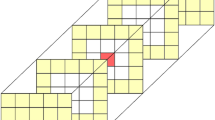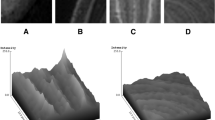Abstract
In this study, it was aimed to evaluate the dorsal striatum nuclei of patients diagnosed with Functional Neurological Disorder by texture analysis method from magnetic resonance imaging images and to compare them with healthy controls. Study groups consisted of 20 female patients and 20 healthy women. The brains of patients and controls were scanned for high-resolution images with a 1.5T scanner using the sagittal plane and 3D spiral fast spin echo sequence. Using the texture analysis method, mean, standard deviation, minimum, maximum, median, variance, entropy, size %L, size %U, size %M, kurtosis, skewness and homogeneity values of the dorsal striatum nuclei were calculated from the images. The data were compared with comparison tests according to Kolmogorov–Smirnov test results. There was no statistically significant difference between paired regions in terms of texture analysis findings in the cross-sectional images of the participants. In patients, mean, standard deviation, minimum, maximum, median, variance and entropy values for the putamen nucleus, and mean, standard deviation, minimum, maximum, median, variance, entropy and kurtosis values for the caudate nucleus were found significantly higher than controls. Additional receiver operating characteristic curve and logistic regression analyzes were performed. The implications of the results of the study are that there are significant microstructural changes in the dorsal striatum nuclei of patients and their reflection on brain images. Texture analysis is a useful technique to show tissue changes in the dorsal striatum of patients using images. It is highly recommended to use texture analysis to identify and evaluate potentially affected areas of the brain in new studies.






Similar content being viewed by others
References
Alam, F. I., & Faruqui, R. U. (2011). Optimized calculations of haralick texture features. European Journal of Scientific Research, 50(4), 543–553.
Alic, L., Niessen, W. J., & Veenland, J. F. (2014). Quantification of heterogeneity as a biomarker in tumor imaging: A systematic review. PLoS ONE, 9(10), e110300. https://doi.org/10.1371/journal.pone.0110300
American Psychiatric Association., American Psychiatric Association., DSM-5 Task Force. (2013). Diagnostic and statistical manual of mental disorders: DSM-5 (5th ed.). American Psychiatric Association.
Atmaca, M., Aydin, A., Tezcan, E., Poyraz, A. K., & Kara, B. (2006). Volumetric investigation of brain regions in patients with conversion disorder. Progress in Neuro-Psychopharmacology and Biological Psychiatry, 30(4), 708–713. https://doi.org/10.1016/j.pnpbp.2006.01.011
Atmaca, M., Baykara, S., Mermi, O., Yildirim, H., & Akaslan, U. (2016). Pituitary volumes are changed in patients with conversion disorder. Brain Imaging and Behavior, 10(1), 92–95. https://doi.org/10.1007/s11682-015-9368-6
Aybek, S., Nicholson, T. R., Draganski, B., Daly, E., Murphy, D. G., David, A. S., & Kanaan, R. A. (2014a). Grey matter changes in motor conversion disorder. Journal of Neurology, Neurosurgery and Psychiatry, 85(2), 236–238. https://doi.org/10.1136/jnnp-2012-304158
Aybek, S., Nicholson, T. R., Zelaya, F., O’Daly, O. G., Craig, T. J., David, A. S., & Kanaan, R. A. (2014b). Neural correlates of recall of life events in conversion disorder. JAMA Psychiatry, 71(1), 52–60. https://doi.org/10.1001/jamapsychiatry.2013.2842
Aybek, S., Nicholson, T. R., O’Daly, O., Zelaya, F., Kanaan, R. A., & David, A. S. (2015). Emotion-motion interactions in conversion disorder: An FMRI study. PLoS ONE, 10(4), e0123273. https://doi.org/10.1371/journal.pone.0123273
Balleine, B. W., Delgado, M. R., & Hikosaka, O. (2007). The role of the dorsal striatum in reward and decision-making. Journal of Neuroscience, 27(31), 8161–8165. https://doi.org/10.1523/JNEUROSCI.1554-07.2007
Baykara, M., & Sagiroglu, S. (2019). An evaluation of magnetic resonance imaging with histogram analysis in patients with idiopathic subjective tinnitus. Nothern Clinics of Istanbul, 6(1), 59–63. https://doi.org/10.14744/nci.2018.72593
Baykara, M., Koca, T. T., Demirel, A., & Berk, E. (2018). Magnetic resonance imaging evaluation of the median nerve using histogram analysis in carpal tunnel syndrome. Neurological Sciences and Neurophysiology, 35, 145–150.
Baykara, S., Baykara, M., Mermi, O., Yildirim, H., & Atmaca, M. (2021). Magnetic resonance imaging histogram analysis of corpus callosum in a functional neurological disorder. Turkish Journal of Medical Sciences, 51(1), 140–147. https://doi.org/10.3906/sag-2004-252
Castellano, G., Bonilha, L., Li, L. M., & Cendes, F. (2004). Texture analysis of medical images. Clinical Radiology, 59(12), 1061–1069. https://doi.org/10.1016/j.crad.2004.07.008
de Oliveira, M. S., Betting, L. E., Mory, S. B., Cendes, F., & Castellano, G. (2013). Texture analysis of magnetic resonance images of patients with juvenile myoclonic epilepsy. Epilepsy & Behavior, 27(1), 22–28.
Dhruv, B., Mittal, N., & Modi, M. (2019). Study of Haralick’s and GLCM texture analysis on 3D medical images. International Journal of Neuroscience, 129(4), 350–362. https://doi.org/10.1080/00207454.2018.1536052
Elkommos, S., & Mula, M. (2021). A systematic review of neuroimaging studies of depression in adults with epilepsy. Epilepsy & Behavior, 115, 107695. https://doi.org/10.1016/j.yebeh.2020.107695
Ganeshan, B., Miles, K. A., Young, R. C., & Chatwin, C. R. (2007). Hepatic entropy and uniformity: Additional parameters that can potentially increase the effectiveness of contrast enhancement during abdominal CT. Clinical Radiology, 62(8), 761–768. https://doi.org/10.1016/j.crad.2007.03.004
Ganeshan, B., Miles, K. A., Young, R. C., & Chatwin, C. R. (2009). Texture analysis in non-contrast enhanced CT: Impact of malignancy on texture in apparently disease-free areas of the liver. European Journal of Radiology, 70(1), 101–110. https://doi.org/10.1016/j.ejrad.2007.12.005
Giedd, J. N., Raznahan, A., Mills, K. L., & Lenroot, R. K. (2012). Review: Magnetic resonance imaging of male/female differences in human adolescent brain anatomy. Biology of Sex Differences, 3(1), 19. https://doi.org/10.1186/2042-6410-3-19
Haralick, R. M. (1979). Statistical and structural approaches to texture. Proceedings of the IEEE, 67(5), 786–804.
Hett, K., Lyu, I., Trujillo, P., Lopez, A. M., Aumann, M., Larson, K. E., & Claassen, D. O. (2021). Anatomical texture patterns identify cerebellar distinctions between essential tremor and Parkinson’s disease. Human Brain Mapping, 42, 2322.
Kassner, A., & Thornhill, R. E. (2010). Texture analysis: A review of neurologic MR imaging applications. AJNR. American Journal of Neuroradiology, 31(5), 809–816. https://doi.org/10.3174/ajnr.A2061
Kurtul, N., & Baykara, M. (2018). The association between MRI texture analysis and chemoradiotherapy outcomes in glioblastoma cases. Annals of Medical Research, 25(4), 1.
Latha, M., & Kavitha, G. (2018). Segmentation and texture analysis of structural biomarkers using neighborhood-clustering-based level set in MRI of the schizophrenic brain. Magma, 31(4), 483–499. https://doi.org/10.1007/s10334-018-0674-z
McLaren, C. E., Chen, W. P., Nie, K., & Su, M. Y. (2009). Prediction of malignant breast lesions from MRI features: A comparison of artificial neural network and logistic regression techniques. Academic Radiology, 16(7), 842–851. https://doi.org/10.1016/j.acra.2009.01.029
Molina, D., Perez-Beteta, J., Luque, B., Arregui, E., Calvo, M., Borras, J. M., et al. (2016). Tumour heterogeneity in glioblastoma assessed by MRI texture analysis: A potential marker of survival. British Journal of Radiology, 89(1064), 20160242. https://doi.org/10.1259/bjr.20160242
Perera, B., Courtenay, K., Solomou, S., Borakati, A., & Strydom, A. (2020). Diagnosis of attention deficit hyperactivity disorder in intellectual disability: diagnostic and statistical manual of mental disorder V versus clinical impression. Journal of Intellectual Disability Research, 64(3), 251–257. https://doi.org/10.1111/jir.12705
Radulescu, E., Ganeshan, B., Shergill, S. S., Medford, N., Chatwin, C., Young, R. C., & Critchley, H. D. (2014). Grey-matter texture abnormalities and reduced hippocampal volume are distinguishing features of schizophrenia. Psychiatry Research, 223(3), 179–186. https://doi.org/10.1016/j.pscychresns.2014.05.014
Reynolds, E. H. (2012). Hysteria, conversion and functional disorders: A neurological contribution to classification issues. British Journal of Psychiatry, 201(4), 253–254. https://doi.org/10.1192/bjp.bp.111.107219
Sudheesh, K., & Basavaraj, L. (2021). Qualitative approach of empirical mode decomposition-based texture analysis for assessing and classifying the severity of alzheimer’s disease in brain mri images. In Advances in Artificial Intelligence and Data Engineering (pp. 1227–1253). Singapore: Springer.
Suo, S. T., Zhuang, Z. G., Cao, M. Q., Qian, L. J., Wang, X., Gao, R. L., et al. (2016). Differentiation of pyogenic hepatic abscesses from malignant mimickers using multislice-based texture acquired from contrast-enhanced computed tomography. Hepatobiliary & Pancreatic Diseases International, 15(4), 391–398. https://doi.org/10.1016/s1499-3872(15)60031-5
Tixier, F., Hatt, M., Le Rest, C. C., Le Pogam, A., Corcos, L., & Visvikis, D. (2012). Reproducibility of tumor uptake heterogeneity characterization through textural feature analysis in 18F-FDG PET. Journal of Nuclear Medicine, 53(5), 693–700. https://doi.org/10.2967/jnumed.111.099127
Vuilleumier, P. (2014). Brain circuits implicated in psychogenic paralysis in conversion disorders and hypnosis. Neurophysiologie Clinique, 44(4), 323–337. https://doi.org/10.1016/j.neucli.2014.01.003
Vuilleumier, P., Chicherio, C., Assal, F., Schwartz, S., Slosman, D., & Landis, T. (2001). Functional neuroanatomical correlates of hysterical sensorimotor loss. Brain, 124(Pt 6), 1077–1090. https://doi.org/10.1093/brain/124.6.1077
Weber, C. E., Wittayer, M., Kraemer, M., Dabringhaus, A., Platten, M., Gass, A., & Eisele, P. (2021). Quantitative MRI texture analysis in chronic active multiple sclerosis lesions. Magnetic Resonance Imaging, 79, 97–102. https://doi.org/10.1016/j.mri.2021.03.016
Yang, D., Rao, G., Martinez, J., Veeraraghavan, A., & Rao, A. (2015). Evaluation of tumor-derived MRI-texture features for discrimination of molecular subtypes and prediction of 12-month survival status in glioblastoma. Medical Physics, 42(11), 6725–6735. https://doi.org/10.1118/1.4934373
Yildirim, M., & Baykara, M. (2020). Differentiation of multiple myeloma and lytic bone metastases: Histogram analysis. Journal of Computer Assisted Tomography, 44(6), 953–955. https://doi.org/10.1097/RCT.0000000000001086
Funding
This research was financially supported by Firat University Scientific Research Projects Unit (FUBAP Project No: TF.13.40).
Author information
Authors and Affiliations
Contributions
Author contributions included conception and study design (MB and SB), data collection or acquisition (SB), statistical analysis (MB), interpretation of results (MB and SB), drafting the manuscript work or revising it critically for important intellectual content (MB and SB) and approval of final version to be published and agreement to be accountable for the integrity and accuracy of all aspects of the work (MB and SB).
Corresponding author
Ethics declarations
Ethical approval
The local Firat University Non-Interventional Researchs Ethics Committee have reviewed and approved the study protocol described in the manuscript.
Conflict of interest
None of the authors have a conflict of interest to declare.
Additional information
Publisher's Note
Springer Nature remains neutral with regard to jurisdictional claims in published maps and institutional affiliations.
Rights and permissions
About this article
Cite this article
Baykara, M., Baykara, S. Texture analysis of dorsal striatum in functional neurological (conversion) disorder. Brain Imaging and Behavior 16, 596–607 (2022). https://doi.org/10.1007/s11682-021-00527-3
Accepted:
Published:
Issue Date:
DOI: https://doi.org/10.1007/s11682-021-00527-3




